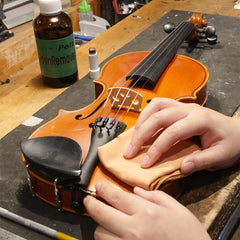BOOK AN APPOINTMENT
Book an Appointment


Looking for some help with finger placement, forming the perfect bow hold or bow placement on the strings? Check out our range of violin teaching aids.
Shop beginner accessories packs | Shop violin teaching aids

A shoulder rest is an accessory that attaches to the back of your violin to support the instrument on your shoulder whilst playing.
Shoulder rests help to promote good posture, make the violin more comfortable to hold and help prevent neck and back problems from developing. Unless your teacher says otherwise, we strongly recommend the use of a shoulder rest.The type of shoulder rest you buy will depend on the curve of your shoulder and the height of your neck. For beginners, we recommend 'The Everest' as it fits most body types, however it is always best to come in and get fitted by one of our trained staff members before purchasing. Click to view our video on the Everest shoulder rest range.
Young violinists between 2-5 years old may only require a sponge as support, if their neck is too small to accomodate a shoulder rest. For these players we stock a fun range of violins sponges called 'Magic Pads'. 'Tido Pads' are another great option for young violinists that also provide comfort around the chin rest.


Rosin creates friction between the bow hair and the strings, allowing the strings to vibrate. Without rosin, your violin won't produce any sound!
Rosin is something that string players apply to the horsehair of their bow so that the bow grips the string. The constant friction between the string and the bow makes the string vibrate. This vibration is amplified by the body of the instrument to create sound.
Rosin comes as a hard, solid block or cake and when applied to the bow hair, becomes a fine white powder. For beginners, we recommend a good quality student rosin such as Paganini Cloth (suitable for players 6 or older), or Paganini Cork (a smaller version recommended for players 6 and under).
More information on rosin: What is rosin and how is it made? | Which rosin should I use? | How often should I rosin my bow? | Does violin rosin expire? | Can rosin damage my instrument or bow?

Having a music stand helps create a special space at home where the player feels inspired to practice.
Like any other discipline, playing the violin requires regular practice, which can come as a challenge for many parents. One of the ways you can help encourage and enable your kids to practice is by creating a dedicated practice space at home.
Using a music stand not only helps to promote good posture and puts the sheet music in a prominent position to read, but it also helps to create that special spot for the player to sit down a play.
For beginners, if you're looking for something that can collapse for easy storage, we recommend the Peak SMS-10.
If you want to keep your music out on display, ready to play 24-7, we recommend something with a solid desk such as the SMS-32 or SMS-20.


Tuning your violin is something you need to do each time you play, and a digital tuner can make this process much easier.
As a beginner, the thought of having to tune your instrument without your teacher can be quite nerve-racking! However, practice makes perfect, and with the help of a digital tuner, you'll be a pro in no time.
A digital tuner lets you know what note you are playing, and whether that note is sharp or flat, so that you can make the appropriate adjustment. For the most part, you'll only need to use the fine tuners, however if you are keen to learn how to tune with the pegs, we recommend watching our video on 'How To Tune Your Violin' below.
For beginners, we recommend the 'Aroma Rechargeable Chromatic Tuner'.
Click to view our full range of tuners.

It is very important to wipe your violin down after each time you play to prevent the build-up of rosin on your instrument.
When you play, rosin dust falls onto the strings and body of your violin. This dust is very easy to get off when it's fresh, but becomes very difficult to get off if it's left on there for a long period of time.
If left for too long, rosin can even become embedded in the varnish causing irreversible damage.
To avoid damage to your instrument, and to increase the longevity and playing qualities of your strings, wipe down your instrument and strings with a microfiber cleaning cloth after each use. We recommend the 'Tido Instrument Cleaning Cloth'.
The Sydney String Centre sits on the unceded lands of the Gamaragal people. We pay our respects to Elders and communities past, present, and emerging. We celebrate the stories, culture and traditions of Aboriginal and Torres Strait Islander people who also work and live on this land.
